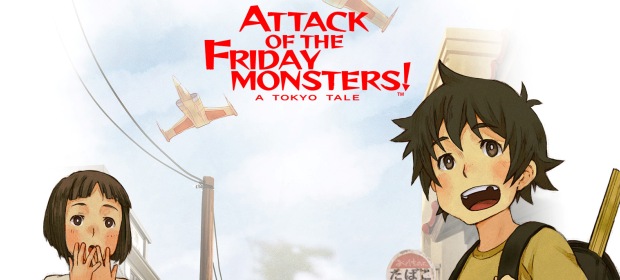There is definitely something distinctly Miyazaki-esque about the way Kay Ayabe goes about his work, creating beautifully observed slices of small-town nostalgia, served up from a child’s perspective. He follows his popular My Summer Vacation series with this delightful eShop exclusive treat, which completes what has been an undeniably enjoyable Guild02 trilogy. This will probably be the first time most Western gamers have been able to get to grips with the works of Millennium Kitchen, and even though the translation is first-rate throughout, you will not play a more Japanese game this year.
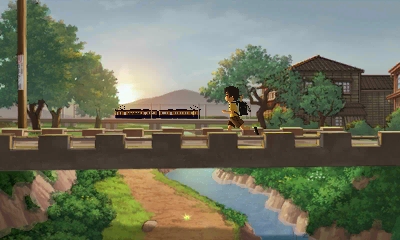 Proceedings open with a terrific, extremely funny theme song – which sets the scene splendidly and evokes fond memories of the similar intro to Ghibli’s peerless My Neighbor Totoro. It is 1971, and you assume the role of Sohta – a wide-eyed young man who has recently moved to a Tokyo suburb with his parents who run a dry cleaning service. The beautifully-rendered little town is full of quirky characters and surprises – but none more so than the revelation that every Friday, enormous Kaiju characters clash on a patch of waste ground, much to the delight of the monster-obsessed Sohta and his rag-tag group of friends. The game takes place over the course of one day, which just so happens to be a Friday…
Proceedings open with a terrific, extremely funny theme song – which sets the scene splendidly and evokes fond memories of the similar intro to Ghibli’s peerless My Neighbor Totoro. It is 1971, and you assume the role of Sohta – a wide-eyed young man who has recently moved to a Tokyo suburb with his parents who run a dry cleaning service. The beautifully-rendered little town is full of quirky characters and surprises – but none more so than the revelation that every Friday, enormous Kaiju characters clash on a patch of waste ground, much to the delight of the monster-obsessed Sohta and his rag-tag group of friends. The game takes place over the course of one day, which just so happens to be a Friday…
Ayabe does a tremendous job of capturing the fantastical role-playing that kids buy into, blurring the lines between fantasy and reality to fashion an uplifting, heart-warming tale that explores issues of fatherhood, childhood hopes and aspirations and the old chestnut of an exchange student coming to terms with fitting in to their new surroundings, and it does so with a warm humour that can be enjoyed by gamers of all ages. Kids will lap up the giant monster craziness and the silly games the youngsters play, whilst the older and wiser among us will totally get the over-arching themes of responsibility, and all the sensitively-handled “grown-up” stuff.
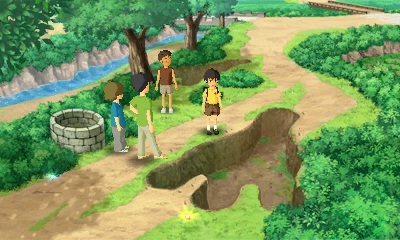 Sohta’s adventure unfolds in a series of inter-flowing “chapters” which open and close as you carry out certain tasks – usually talking to people in order to gather information. Each of the chapters is numbered, with a handy numerical icon usually popping up on the map screen to show you where to go next. The term “gameplay” is to be used rather loosely, as this is very much a story driven affair, and plays more like an interactive book than a traditional adventure.
Sohta’s adventure unfolds in a series of inter-flowing “chapters” which open and close as you carry out certain tasks – usually talking to people in order to gather information. Each of the chapters is numbered, with a handy numerical icon usually popping up on the map screen to show you where to go next. The term “gameplay” is to be used rather loosely, as this is very much a story driven affair, and plays more like an interactive book than a traditional adventure.
The conversations and basic exploratory sections are joined by the fun card battle system, which does play a small role in beating the game, but is mostly just a distraction. Dotted around the landscape, and awarded upon completion of certain chapters, are small, shiny crystals known as Glims. Collecting seven of a particular type of Glim will award you a Monster Card. Once you have a deck of five cards, you can initiate Janken-style duels with your friends, using the time-honoured rock/paper/scissors principle. You can combine cards together to make them more powerful, something which comes in handy in a stalemate situation, when the HP of a card will affect whether you win or lose. Later on you may pick up a special card that has the benefit of being able to emerge victorious in more than one situation.
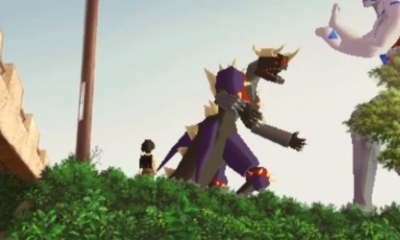 Your prize for winning a card game is to become your opponent’s “boss”, and as per the amusing playground lore that the children live by, this gives you the ability to cast a “spell” which causes them to do something silly such as fall over, or dance inappropriately. More importantly, once someone is defeated they are more forthcoming with information, which can help glean hints as to where to go next. There is no risk/reward thing going on here – losing a battle will not lose you your cards – it is all very friendly and civil. Apart from one lone occasion, the card battles are not even a necessity to complete the game, which renders them rather meaningless when looking back with hindsight.
Your prize for winning a card game is to become your opponent’s “boss”, and as per the amusing playground lore that the children live by, this gives you the ability to cast a “spell” which causes them to do something silly such as fall over, or dance inappropriately. More importantly, once someone is defeated they are more forthcoming with information, which can help glean hints as to where to go next. There is no risk/reward thing going on here – losing a battle will not lose you your cards – it is all very friendly and civil. Apart from one lone occasion, the card battles are not even a necessity to complete the game, which renders them rather meaningless when looking back with hindsight.
Sadly, after a mere couple of hours, just as you start to attain some nice powerful cards, after you have met and started to get to know the charming village denizens, and have begun to thoroughly enjoy the prospect of spending more time there and winning more challenging janken dust-ups… it fizzles out. Sure, there are some nice resolutions to the story threads, and the game does offer a “new game+”-type opportunity to continue searching the town for more Glims and more card battles, but when the credits roll, the feeling of disappointment washes over you. Chances are you won’t want it to end.
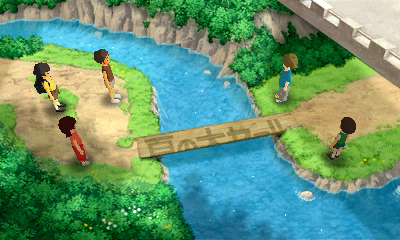 The very definition of short and sweet, this is a thing of beauty in so many ways. Considering its meagre length and relatively under-the-radar profile, some of the things Millennium Kitchen have got so right here completely shame other full-priced titles. Beautiful hand-painted backdrops, the wonderfully told story and surprisingly sharp script – and the music, oh, the music, all of which was written originally for the game, is astonishing. It’s probably one of the best game soundtracks this year, in fact.
The very definition of short and sweet, this is a thing of beauty in so many ways. Considering its meagre length and relatively under-the-radar profile, some of the things Millennium Kitchen have got so right here completely shame other full-priced titles. Beautiful hand-painted backdrops, the wonderfully told story and surprisingly sharp script – and the music, oh, the music, all of which was written originally for the game, is astonishing. It’s probably one of the best game soundtracks this year, in fact.
VERDICT: It is easy to understand why the works of the auteur are so popular and critically acclaimed in the land of their origin. Their pastoral 70s settings and laid-back nature of the “gameplay” makes a refreshing change from the norm. Like controlling the destiny of your very own, highly entertaining anime, Attack of the Friday Monsters works like a charm. The current generation of handhelds are perfectly set up for games of this type, and one hopes that more splendid localisation efforts reach us in due course.

VERY GOOD. An 8/10 is only awarded to a game we consider truly worthy of your hard-earned cash. This game is only held back by a smattering of minor or middling issues and comes highly recommended.


